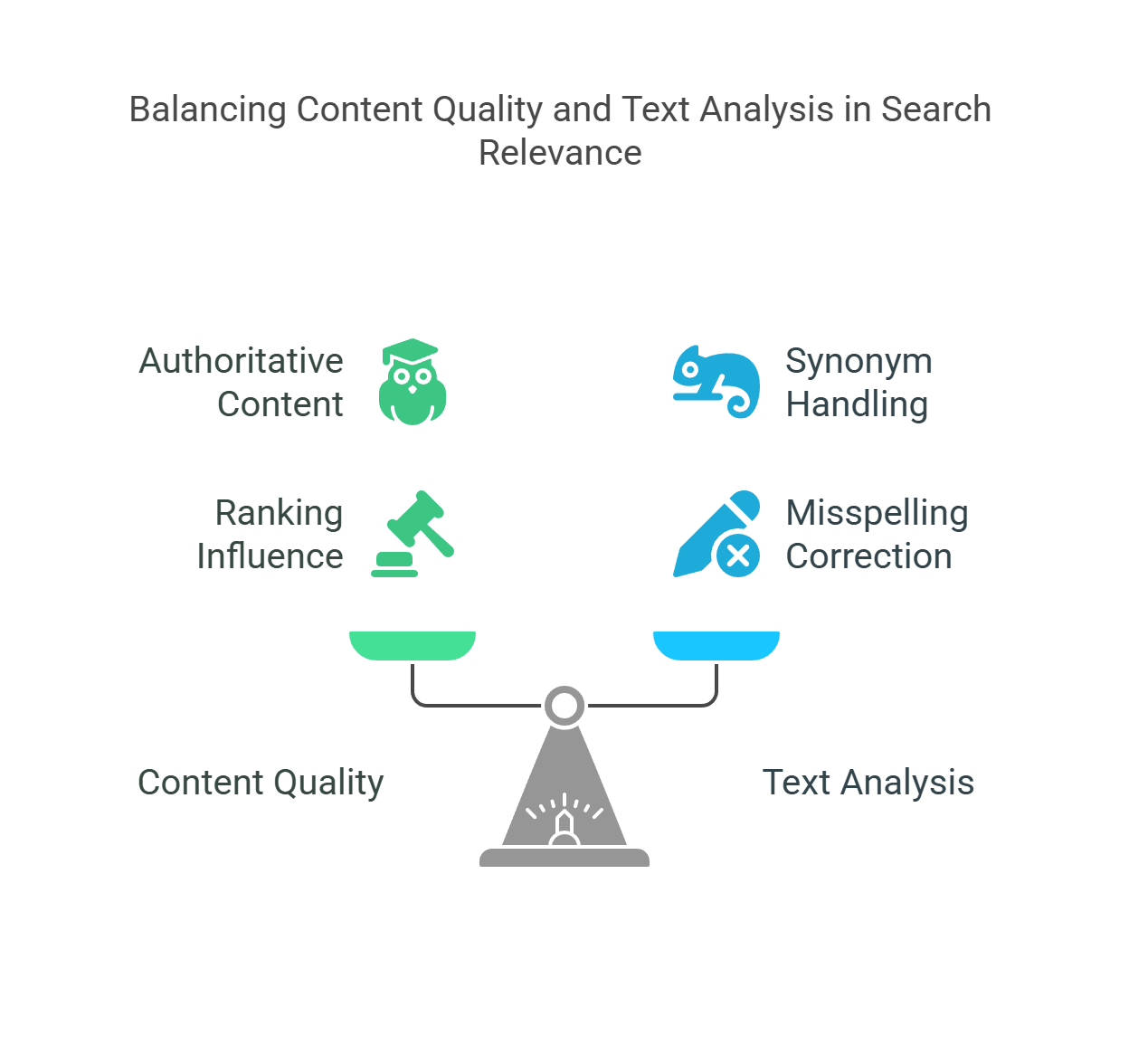Imagine typing “best running shoes for flat feet” into a search bar and getting results for trail shoes or sandals. Frustrating, right? That’s where search relevance comes in—it ensures search engines understand what you mean, not just what you type.
We’ll cover:
- What search relevance really means
- Why it matters for business and user experience
- Key factors that drive relevance
- Common challenges and how to fix them
- Actionable strategies to improve relevance
What is search relevance?
Search relevance is all about how well search results match not just what a user types (their query) but, more importantly, what they truly mean (their underlying intent). It's the bridge between a search term and the actual information served up, gauging if those results genuinely meet the user's needs and expectations. When search relevance works well, it transforms a basic lookup tool into a smart assistant that seems to anticipate and satisfy what users are looking for.
Example: A user searching for “apple” could mean:
- The fruit (nutrition info)
- The company (Apple Inc.)
- A product (iPhone)
Understanding which the user means—based on context—is core to relevance
At its heart, search relevance is about making sense of the link between a query and a mountain of possible answers, ensuring the presented information isn't just keyword-related but actually hits the mark for that specific user and their goal. It's important to note that relevance itself can be subjective, varying between users even when the query is identical.
Why has search relevance become so critical?
The significance of search relevance in today's digital world can't be stressed enough. It's shifted from a nice-to-have feature to an absolute must, deeply affecting how users behave, how businesses fare, and how we interact online generally. Its heightened importance stems from several key factors. Users now expect more, thanks to the slick search experiences on major platforms; they want accurate results, fast, and anything less is a letdown. The search bar is often a first touchpoint, and poor relevance here creates a bad first impression that can turn users away.
Why it matters now more than ever:
- User expectations are higher. Google, Amazon, and Spotify have set the bar.
- Poor search = poor UX. 68% of users won’t return to a site with bad search results.
- First impressions count. The search bar is often the first and most-used interface.
Good search relevance also builds user loyalty and keeps them coming back, whereas bad experiences send them straight to competitors. In the cutthroat digital marketplace, serving up highly relevant results quickly is vital for getting noticed and gaining a competitive advantage, especially since most search traffic sticks to the first page, with many users often not venturing beyond the top 3-5 results. Strong search relevance dramatically improves the overall customer experience and satisfaction, making online interactions smoother, more fruitful, and more pleasant, which directly builds loyalty and turns customers into advocates.

What are the key components that define search relevance?
Key components of search relevance:
- Content Quality: Well-structured, trustworthy information is more likely to rank well.
- Query Understanding: Parsing what the user means (e.g., “cheap flights” = price-sensitive intent).
- Ranking Algorithms: Balancing freshness, popularity, and keyword match.
- User Feedback Signals: Click-throughs, bounce rate, dwell time.
What role do text analysis and keyword relevance play?
At its foundation, search matches terms from a user's query to content in articles, web pages, documents, or product descriptions. This text analysis is tricky because natural language is full of subtleties. Advanced systems need to handle:
- synonyms (laptop vs. notebook) ,
- word variations (like run, running, ran),
- misspellings,
- regional spelling variations (e.g., color vs. colour),
- phonetic spellings.
How often and where keywords appear (keyword relevance) also matters, though modern systems are much smarter than just looking for stuffed keywords.

6 contextual factors that influence search relevance
Contextual factors influence search relevance by providing deeper clues about a user's intent and the relative importance of different content, which helps search engines pick up on query nuances and fine-tune results more effectively. Important contextual factors that provide these signals include:
- user behavior analytics, like click-through rates, how long users stay on a page (dwell time), and conversion rates for particular results,
- location data, which is key for local searches or queries tied to a specific geography. Searching “pizza” in Chicago vs. Naples yields very different needs.
- popularity metrics, showing which content is frequently visited or highly rated by others,
- search history, which allows for tailoring results based on a user's past searches,
- the user's geolocation, offering immediate geographical context,
- keyword proximity within the content, where terms appearing close together might suggest stronger relevance. “Dog food ingredients” ≠ “food for dog with special ingredients.”
These signals help the search engine pick up on the nuances of a query and fine-tune results more effectively.
What challenges impede the achievement of optimal search relevance?
Despite its importance, creating and maintaining a truly relevant search experience is packed with challenges. These arise from the natural complexities of language, user behavior, and technical hurdles, demanding ongoing effort and innovative approaches. A significant challenge lies in context dependency; relevance critically depends on context, which itself is made up of many, often fast-changing, elements. This makes it tough to consistently figure out what's relevant for different users, or even the same user in different situations. Site-specific ranking needs also mean custom approaches are necessary; understanding the specific context of what is site search reveals that an e-commerce site prioritizing product discovery and sales has very different needs from an academic portal focused on the authority and detail of research papers, so a one-size-fits-all ranking seldom works.
Dealing with varied user intents and skill levels adds another layer of difficulty, as people search with different levels of subject knowledge, search abilities, and, importantly, different goals even when using similar keywords. The sheer complexity of natural language is a considerable barrier; search systems must wrestle with the many ways people describe the same idea—using synonyms, slang, idioms—and manage word variations, regional spellings, and common typos to grasp the real meaning behind a query, tasks heavily reliant on advancements in natural language search. Finally, many existing enterprise search platforms, especially older or less advanced ones, have their limits. They often lack the sophisticated tools needed to truly understand user intent and deliver consistently relevant results, frequently relying on outdated algorithms or missing the infrastructure to process rich contextual data, which leads to poor search experiences within organizations.

How can search relevance be effectively optimized?
Optimizing search relevance is a continuous job, blending algorithmic tweaks, linguistic smarts, and a sharp focus on user needs. Website owners and developers can use several strategies to greatly improve their search results' accuracy and usefulness, leading to happier users and better business outcomes. This also means striking a careful balance: meeting users' explicit needs while also achieving underlying business goals. While the main aim is to help users find what they're looking for, search can also be used strategically to steer users towards key content, new products, or items that fit business priorities—as long as this doesn't undermine the core relevance of the results.
Fine-tuning algorithms for intent and priority
A key part of optimization is constantly fine-tuning search algorithms. This means adjusting how search results are ordered and weighted based on a better grasp of search intent, specific business priorities (like promoting certain products or content), and subtle textual relevance signals. This ongoing process helps align search results more closely with both user expectations and strategic aims.
Implementing advanced linguistic analysis
Using Natural Language Processing (NLP) techniques helps search systems better understand the meaning and intent behind user queries, instead of just matching keywords. Advanced linguistic analysis can make sense of complex queries, spot entities, understand word relationships, and handle ambiguities, directly enhancing the accuracy of the results. This involves advanced techniques for dealing with synonyms, word stemming, and semantic understanding, all crucial aspects that power effective semantic search.
Developing sophisticated ranking algorithms
Creating and refining sophisticated ranking algorithms is essential for relevance optimization. These algorithms need to juggle numerous factors, including keyword matches, content quality, user engagement signals, how fresh the information is, and source authority. Machine learning is increasingly used to build models that can learn from user interactions and automatically make rankings more effective over time, often employing specific methodologies like Learning to Rank (LTR).
Benefit: Learns from real user clicks.
Leveraging personalization and contextual understanding
For top-notch search relevance, systems must increasingly use personalization and deep contextual understanding. This involves tailoring search results based on individual user profiles, their past behavior, their current situation (like location, device, or even department in a company), and the subtle clues in their queries. By understanding who is searching and why, search engines can provide far more fitting information.




